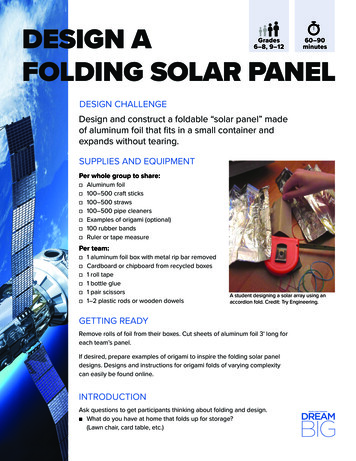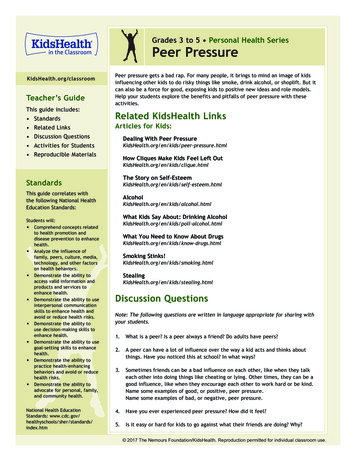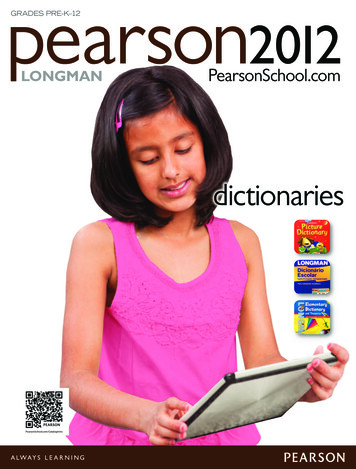
Transcription
Grades 9 to 12Fashion Design andTechnologyManitoba Technical-VocationalCurriculum Frameworkof Outcomes
Gr ades 9 to 12Fa shion DesignTe c h n o l o g yandManitoba Technical-Vocational CurriculumFramework of Outcomes2017M a ni t o b a E d u c a t i o n a n d Tr ainin g
Manitoba Education and Training Cataloguing in Publication DataGrades 9 to 12 fashion design and technology : Manitobatechnical-vocational curriculum framework of outcomesIncludes bibliographical referencesISBN: 978-0-7711-7498-8 (pdf)1. Fashion design—Study and teaching (Secondary)—Manitoba.2. Fashion—Study and teaching (Secondary)—Manitoba.3. Clothing and dress—Study and teaching (Secondary)—Manitoba.4. Technical education—Manitoba—Curricula.5. Vocational education—Manitoba—Curricula.I. Manitoba. Manitoba Education and Training.746.92Copyright 2017, the Government of Manitoba, represented by the Minister ofEducation and Training.Manitoba Education and TrainingSchool Programs DivisionWinnipeg, Manitoba, CanadaEvery effort has been made to acknowledge original sources and to complywith copyright law. If cases are identified where this has not been done, pleasenotify Manitoba Education and Training. Errors or omissions will be correctedin a future edition. Sincere thanks to the authors and publishers who allowedtheir original material to be used.Any websites referenced in this resource are subject to change without notice.Educators are advised to preview and evaluate websites and online resourcesbefore recommending them for student use.This resource is available on the Manitoba Education and Training websiteat www.edu.gov.mb.ca/k12/cur/teched/sy tech program.html.Available in alternate formats upon request.
ContentsGrades 9 to 11 Fashion Design and Technology:General and Specific Learning Outcomes by Goal13Goal 1: Describe and apply health and safety practices. 13AcknowledgementsTechnical-Vocational Education OverviewFashion Design and Technology OverviewvGoal 2: Identify, select, describe, use, and manageequipment, tools, and materials.151Goal 3: Demonstrate the transferable cross-curricularknowledge and skills related to reading, interpreting,and communicating information relevant to fashion.151Goal 4: Demonstrate an awareness of historicalinfluences, technological progression, and emergingtrends as inspirational sources for design.16Goal 5: Demonstrate an understanding of thecharacteristics, properties, and end use of textiles.17Goal 6: Demonstrate an understanding of the designprocess through the implementation of various artisticrenderings.18Goal 7: Demonstrate an understanding of garmentpatterning techniques.19Goal 8: Demonstrate an understanding of garmentconstruction based on industrial standards.21Goal 9: Demonstrate an understanding of theapplication of embellishing techniques to thesurface of textiles.24Goal 10: Demonstrate an awareness of sustainability.24Goal 11: Demonstrate an awareness of ethical andlegal standards.25Goal 12: Describe and demonstrate other transferablecross-curricular knowledge and skills relevant tofashion.26Goal 13: Describe and demonstrate employabilityskills.27Goal 14: Demonstrate an understanding of the fashionindustry.29Career Opportunities in Fashion Design and Technology 2Implementation4Curriculum Goals and General Learning Outcomes4Specific Learning Outcomes (SLOs)6Course Descriptions69124 Exploration of Fashion Design and Technology69125 Introduction to Fashion Design and Technology79126 Knitwear Design and Construction79127 Semi-Formal Wear Design and Construction79128 Pant Design and Construction79129 Tailored Garment Design and Construction79131 Formal Wear Design and Construction79132 Applied Textile Design89134 Applied Fashion Entrepreneurship8Curriculum Implementation Dates8Guide to Reading Fashion Design and TechnologyGoals and Learning Outcomes9Contentsiii
Grade 12 Fashion Design and Technology:General and Specific Learning Outcomes by Goal33Goal 1: Describe and apply health and safety practices. 33Goal 2: Identify, select, describe, use, and manageequipment, tools, and materials.34Goal 3: Demonstrate cross-curricular knowledge andskills related to reading, interpreting, andcommunicating information relevant to fashion.35Goal 4: Demonstrate an understanding of historicalinfluences, technological progression, and emergingtrends as inspirational sources for design.35Goal 5: Demonstrate an understanding of thecharacteristics, properties, and end use of textiles.36Goal 6: Demonstrate an understanding of thedesign process through the implementation of variousartistic renderings.36Goal 7: Demonstrate an understanding of garmentpatterning techniques.37Goal 8: Demonstrate an understanding of garmentconstruction based on industrial standards.38Goal 9: Demonstrate an understanding of the applicationof embellishing techniques to the surface of textiles.41ivGoal 10: Demonstrate an awareness of sustainability.42Goal 11: Demonstrate an awareness of ethical andlegal standards.44Goal 12: Describe and demonstrate other transferablecross-curricular knowledge and skills relevant tofashion.44Goal 13: Describe and demonstrate employabilityskills.45Goal 14: Demonstrate an understanding of the fashionindustry.47Grades 9 to 12 Graphic DesignBibliography51
AcknowledgementsManitoba Education and Training gratefully acknowledges the contributions of the following individuals in the development ofGrades 9 to 12 Fashion Design and Technology: Manitoba Technical-Vocational Curriculum Framework of Outcomes.Members of the Development TeamSchool Programs DivisionManitoba Education and TrainingClaudine CharrièreCollège Lorette CollegiateSeine River School DivisionLotte GiesbrechtSteinbach Regional Secondary SchoolHanover School DivisionDenise MillerMurdoch MacKay CollegiateRiver East Transcona School DivisionLouise BoissonneaultCoordinatorDocument Production Services UnitEducational Resources BranchJohn FinchProject ManagerLearning Support and Technology UnitInstruction, Curriculum and Assessment BranchGilles LandryProject LeaderLearning Support and Technology UnitInstruction, Curriculum and Assessment BranchDaniel LemieuxConsultantLearning Support and Technology UnitInstruction, Curriculum and Assessment BranchKim PoirierConsultantLearning Support and Technology UnitInstruction, Curriculum and Assessment BranchMarjorie PoorPublications EditorDocument Production Services UnitEducational Resources BranchLindsay WalkerDesktop PublisherDocument Production Services UnitEducational Resources BranchAcknowledgementsv
Te c h n i c a l- V o c a t i o n a lEduc at ion Overv iewIn 2013, Manitoba Education released the documentTechnical-Vocational Education Overview, available at www.edu.gov.mb.ca/k12/cur/teched/sy tech program.html, toprovide the philosophical and pedagogical underpinningsfor curriculum development and the teaching of courses inthe Senior Years Technology Education Program.This overview presents educators with the vision and goalsof technical-vocational education (TVE) in Manitoba. Topicsinclude the following:QQcurriculum revitalization and renewalQQcurriculum framework and implementationQQarticulation of programmingQQassessment and reportingQQsafetyQQemployability/essential skills and career developmentQQsustainable developmentThe TVE curriculum includes Grades 9 to 12 courses in avariety of areas, including fashion design and technology.Fashion Design andTe c h n o l o g y O v e r v i e wGrades 9 to 12 Fashion Design and Technology: ManitobaTechnical-Vocational Curriculum Framework of Outcomesidentifies the goals, general learning outcomes (GLOs), andspecific learning outcomes (SLOs) for nine fashion designand technology courses. This framework is intended foruse in all Manitoba schools teaching fashion design andtechnology as part of the Senior Years Technology EducationProgram.Fashion design refers to the creative process involved indesigning and constructing apparel. Fashion technologycomplements an ever-changing design process. Fashionpromotes people’s well-being in a variety of ways, includingimproving their appearance, protecting them from theelements, and allowing them to express their individuality.The fashion design and technology curriculum is designed togive a comprehensive overview of the fashion industry as itrelates to the design process, and production and marketingof fashion. The courses combine both the creative andtechnical skills necessary to excel in the industry throughdesign theory and practical applications. Emphasis will beplaced on fashion design, production, and construction skillsportfolios. In the final year, students will demonstrate theknowledge, skills, and attitudes required to participate in asuccessful fashion show.Overview1
Career Opportunities in Fashion Design andTechnologyFashion is a rapidly growing industry that includes a numberof sectors, including fashion design production, marketingand merchandising, and fashion media and promotions.Fashion designers use their knowledge of design principles,techniques, and tools to create sketches and models oforiginal garments, shoes, handbags, and other fashionaccessories. They often specialize in a particular facet ofclothing design, such as men’s, women’s, or children’s wear,or lingerie. While some fashion designers control the entiredesign and marketing process, others use the services ofpatternmakers to create original textiles and trimmings,production managers to oversee the actual creation of thefashion line, and fashion merchandisers to introduce andestablish the designs in the fashion marketplace. Careersinclude the following:2QQfashion merchandiserQQfashion designerQQclothing pattern makerQQfashion sales representativeQQaccessories designerQQproduct managerQQshowroom sales representativeQQpattern graderQQcostume designerQQfashion designerG r a d e s 9 t o 1 2 F a s h i o n D e s i g n a n d Te c h n o l o g yQQassistant fashion designerQQfashion illustratorQQsample makerQQshoe designerQQpattern makerQQtextile artistFashion marketing and merchandising professionals areresponsible for identifying and creating fashion trends tosell the products created by fashion designers. Drawing ontheir knowledge of consumer psychology and trends, theypromote fashion with advertising and visual marketingcampaigns. The fashion merchandising field includes jobssuch as the following in both retail and wholesale sales:QQfashion buyerQQvisual merchandisingQQfashion coordinator and fashion directorQQboutique ownerQQretail merchandiserQQfashion photographer
The fashion industry offers a number of opportunitiesfor creative professionals who are not attracted to thedesign side. Fashion writers and editors are employed bynewspapers, magazines, websites, and other media outletsto keep consumers up-to-date on style trends. Fashionphotographs, illustrators, and stylists are often employedby publishers of catalogues and magazines. Careeropportunities include the following:QQbuyerQQchildren’s clothing designerQQcomputer-aided designerQQcostume designerQQembroidery designerQQfashion colouristfashion stylistQQQQfashion designerfashion editorQQQQfashion directorfashion photographerQQQQassistant fashion designerfashion public relations specialistQQQQfabric librarianfashion illustratorQQQQfashion forecasterfashion writerQQQQfashion illustratorgraphic designerQQQQfashion house managerfashion directorQQQQfashion public relations specialistQQretail salespersonOther fashion career opportunities include costume designfor TV, film, and theatre productions; personal stylistpositions with high-end department stores and privateclients; and modelling work for everything from newspaperadvertisements to fashion show runway production. Specificopportunities include the following:QQcostume designerQQfashion runway modelQQpersonal stylistQQaccount executiveQQapparel business ownerOverview3
ImplementationTo receive a Senior Years Technical Education diploma, astudent must complete eight departmentally developedcourses from an approved technical-vocational cluster,together with 16 compulsory credits and six optional credits.The grade level in which the courses are offered is a localschool-based decision, but it is highly recommended that thesequencing of credits follow the schedule set out at the endof this overview.In most courses, the emphasis is on applied learningactivities. For instructional purposes, the sequence oflearning outcomes can vary based on the activities within thecourse. Teachers are advised to select the learning activitiesbest suited to teach the learning outcomes, based on a varietyof factors, including access to resources or regional needs.The curriculum is not sequential. In other words, learningoutcomes might be taught in an order different from howthey appear in the document.In light of rapid changes in technology, teachers areencouraged to update their learning activities in order tomeet the needs of students and industry.Curriculum Goals and General Learning OutcomesThe learning outcomes for each course in Fashion Design andTechnology were developed based on the following goalsand general learning outcomes (GLOs):Goal 1: Describe and apply health and safety practices.GLO 1.1: Describe and apply appropriate health andsafety practices.Goal 2: Identify, select, describe, use, and manageequipment, tools, and materials.GLO 2.1: Identify, select, describe, use, and manageequipment, tools, and materials.Goal 3: Demonstrate the transferable cross-curricularknowledge and skills related to reading,interpreting, and communicating informationrelevant to fashion.GLO 3.1: Demonstrate the cross-curricular knowledgeand skills related to reading, interpreting,and communicating information relevant tofashion.Goal 4: Demonstrate an awareness of historicalinfluences, technological progression, andemerging trends as inspirational sources fordesign.GLO 4.1: Describe historical influences, technologicalprogression, and emerging trends asinspirational sources f
Fashion designers use their knowledge of design principles, techniques, and tools to create sketches and models of original garments, shoes, handbags, and other fashion accessories. They often specialize in a particular facet of clothing design, such as men’s, women’s, or children’s wear, or lingerie.











